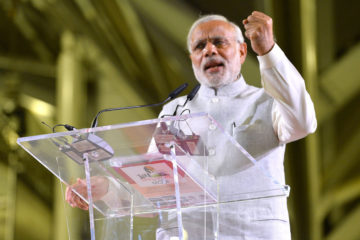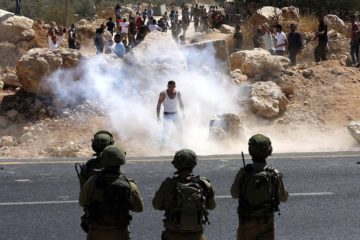“For it is only through the sharing of the personal that we can see each other for who we truly are”
— Terje Rod-Larsen to Palestinian and Israeli delegates
in ‘Oslo’, Harold Pinter Theatre
Violence and fear seem to be embedded in the daily lives of both Palestinians and Israelis. Constant shelling of Israel from Gaza, Israeli police brutality, clashes with settlers in the West Bank, perpetuating oppression of Palestinians, terrorist suicide bombings and stabbings take their toll on the mentality of youth. In such circumstances it is easy to forget about the compassion towards human beings from the other side — the ‘others’ are portrayed as villains. To me, a video producer, it felt like a duty to tell the story of a humanity in crises through my camera.
I was determined to find rays of hope in this chaos. In August I travelled to Israel and Palestine to understand the conflict from both perspectives. I wanted to speak with people who are committed to making a change for the millions of people living in the biblical Holy Land. I wanted to gather material for future endeavours with a film crew. Despite the polarising political narratives, many Israeli and Palestinian grassroots organisations and NGOs fight violence with dialogue. Against all the odds, they prove that individuals are capable of empathy.
One of them is Hand in Hand — a chain of integrated Israeli-Arab schools set up in 1997. With 6 centres based in major cities around the country, their mission is to bring communities from both sides together and build a connection — a shared society for Jews and Arabs in Israel. I met with Gaby Goldman, communications director of the school. Their unique bilingual curriculum stands out from the four government-approved tracks: state-secular, state-religious, independent religious and Arab. These tracks were designed to respect the principle of parental choice and the diversity of Israeli culture — the independent religious schools teach almost entirely orthodox Torah study and very little subjects like maths and science for example. Usually, Muslim and Jewish kids don’t mix. Hand in Hand’s approach sidesteps these divisions. With a ratio of nearly 50:50 Israeli to Arab students, they foster empathy and equality from an early age. Children study the culture of both Israel and Palestine — something that would most certainly not happen otherwise.
Their unique bilingual curriculum stands out from the four government-approved tracks: state-secular, state-religious, independent religious and Arab. These tracks were designed to respect the principle of parental choice and the diversity of Israeli culture — the independent religious schools teach almost entirely orthodox Torah study and very little subjects like maths and science for example. Usually, Muslim and Jewish kids don’t mix. Hand in Hand’s approach sidesteps these divisions. With a ratio of nearly 50:50 Israeli to Arab students, they foster empathy and equality from an early age. Children study the culture of both Israel and Palestine — something that would most certainly not happen otherwise.
Following the national secular track, the Hand in Hand is using the textbooks of the Israeli Ministry of Education complemented by other sources. A few years ago, the official language used in school books concerning the 1948 Arab-Israeli War followed by the Israeli Declaration of Independence was that Arabs “ran away” from the territories, which is only one side of the story. Hand in Hand teachers have to deal with such problems of wording and contexts every day, eventually creating their own curriculum.
 Kids learn in two languages, Arabic and Hebrew, and each class has two teachers. “They don’t translate each other, they complement each other. But it’s not only the language, it’s also the culture and the national stories”, Gaby told me. “For example, we respect holidays of three major religions and children go on vacation on Rosh Hashanah (Jewish New Year), Christmas and Eid al-Adha.”
Kids learn in two languages, Arabic and Hebrew, and each class has two teachers. “They don’t translate each other, they complement each other. But it’s not only the language, it’s also the culture and the national stories”, Gaby told me. “For example, we respect holidays of three major religions and children go on vacation on Rosh Hashanah (Jewish New Year), Christmas and Eid al-Adha.”
Named as the “most intractable conflict”, the Israeli-Palestinian dispute generally divides public opinion into two sides. There are those who support Israel and their right to land and security and there are those who see Palestinians as the victims of Zionism and apartheid. Many Palestinians don’t know the history of Judaism and don’t understand Jews. Many Israelis know nothing about what life in Gaza looks like and generally think that life in the Occupied Territories is the same as in Israel.“Most Israeli Jews will not have met a Palestinian person and usually don’t hear Arabic in the streets,” Gaby said. “When they do hear it, they associate it with the language of the enemy.”
When the award-winning Israeli-Palestinian documentary “5 Broken Cameras” was screened to Israeli youth, they were left speechless. They hadn’t known the horrors of the daily struggle in the West Bank. They were shocked by the soldiers’ brutality and angry at the state for all the lies they had been fed. Similarly, when Palestinians are asked about the Holocaust, they either know almost nothing about it or deny it entirely, seeing it as a hoax. Some even praise the Nazis. To tackle the problem of the gap between communities and their lack of communication, Hand in Hand teaches both points of view on history. They implement a dual narrative method, looking at events with a non-biased approach. But Hand in Hand’s work does not end on teaching.
To tackle the problem of the gap between communities and their lack of communication, Hand in Hand teaches both points of view on history. They implement a dual narrative method, looking at events with a non-biased approach. But Hand in Hand’s work does not end on teaching.
Each school has a community organiser. Their job is to coordinate activities for parents and families. In Wadi Ara (and soon also in Jerusalem) anyone can come to an evening school. Facilitators run sessions during which they study cultural texts and hold dialogue classes, discussing the most sensitive issues of living together — Arabs and Jews, hand in hand.
 The most prominent show of the power and resilience of the Hand in Hand community was the reaction to an arson attack on the school in Jerusalem in 2014. It was a hard blow to the school, teachers and most of all, parents. However, a couple days after the attack, around 2,500 people, including politicians, rabbis, imams and ordinary citizens, showed solidarity with the school by marching together down a main street in Jerusalem. “We were expecting 500 people but about 2,500 people showed up. Most people want to live together and want peace however they define it,” Gaby told VICE.
The most prominent show of the power and resilience of the Hand in Hand community was the reaction to an arson attack on the school in Jerusalem in 2014. It was a hard blow to the school, teachers and most of all, parents. However, a couple days after the attack, around 2,500 people, including politicians, rabbis, imams and ordinary citizens, showed solidarity with the school by marching together down a main street in Jerusalem. “We were expecting 500 people but about 2,500 people showed up. Most people want to live together and want peace however they define it,” Gaby told VICE.
Currently, around 1,700 students learn in 6 centres run by the NGO. The school has great ambitions, but that requires resilience and courage from communities. Each new school is a grassroots movement. It is not the board that decides where the next school will be set up, but it is the citizens themselves who push their municipal representatives to give support to their cause and force them to encourage Hand in Hand to open a new school. Gaby says that “there is a thirst or even a desire for dialogue.” With over 750 families on the school’s waiting list, Hand in Hand wishes to introduce many more neighbourhoods and cities to their mission. Now it is needed more than ever, as the third generation since the conflict started enters adult life.
When parents send their kids to one of these shared schools, they make a choice for life. They have to deal with criticism from their own families. It is not easy, especially in times of violent outbursts, when in one classroom there are Arab kids with families in Gaza who in 2014 were bombed by relatives of their classmates — brothers, uncles, cousins having served in the military at that time. Discussing such controversial matters as war, violence and death with 10-year-olds is not an easy task. But Hand in Hand students are capable of understanding the complex reality of the conflict and at the same time see the humanity of the other side.
The values of understanding, friendship, peace and equality stay with them throughout their adult lives. Mahmood Abu Saleh, who graduated from the Galilee school in 2009 is now a student at Ben Gurion University in Negev. He was the first cohort of the Hand in Hand project and he has witnessed its beginnings. Mahmood started organising activities and projects aimed at bringing the students together. “People at the same university from the same classes didn’t speak to each other because of their religion or ethnicity. It was hard to watch after learning so much from Hand in Hand.” he told me over Skype later that month. “If there’s anything I can do to get them to know each other, then I will do just that. I think I’ve spoken with everyone at my university.” When I got back home, I realised that hope is all that these people have. They have been let down by the international community, they have been let down by the media. What I can do is tell the story — show that not everyone in the Middle-East gave up and that there is still a fight going on. A fight for equality, fraternity and understanding. I will be back in Israel and Palestine next summer to finish my research and bring the story to a wider audience.
When I got back home, I realised that hope is all that these people have. They have been let down by the international community, they have been let down by the media. What I can do is tell the story — show that not everyone in the Middle-East gave up and that there is still a fight going on. A fight for equality, fraternity and understanding. I will be back in Israel and Palestine next summer to finish my research and bring the story to a wider audience.
All international efforts are futile if people don’t communicate with each other. Dialogue between Jews and Arabs is the only hope for the future of Israelis and Palestinians. The fight is not about a bright future, it is about any future. It is time to come together, just like the kids in Hand in Hand do. It is time to understand your neighbours and engage with them, just like Mahmood and dozens of other graduates do. “We keep the network of alumni alive so we know that they are all socially and politically active. We still don’t have a Nobel Peace Prize winner, but it’s a matter of time,” Gaby laughs.
***
Here are some extra pictures from my visit to Shuafat refugee camp in East Jerusalem:





***
Interested in submitting a piece for the Stories from Afar series? Email thelondonglobalist@gmail.com for more details.





